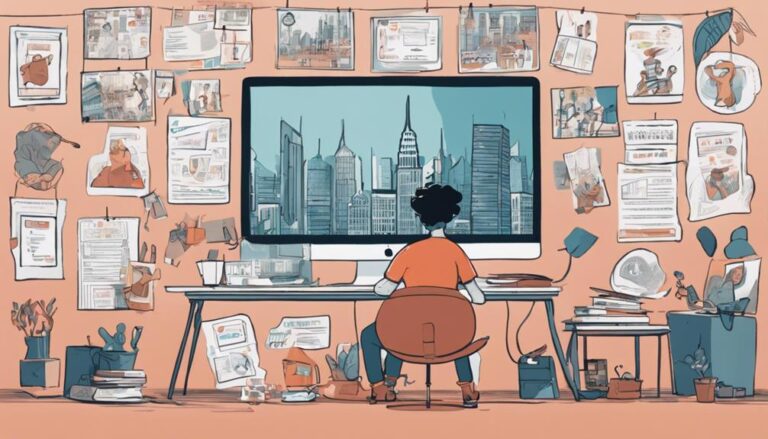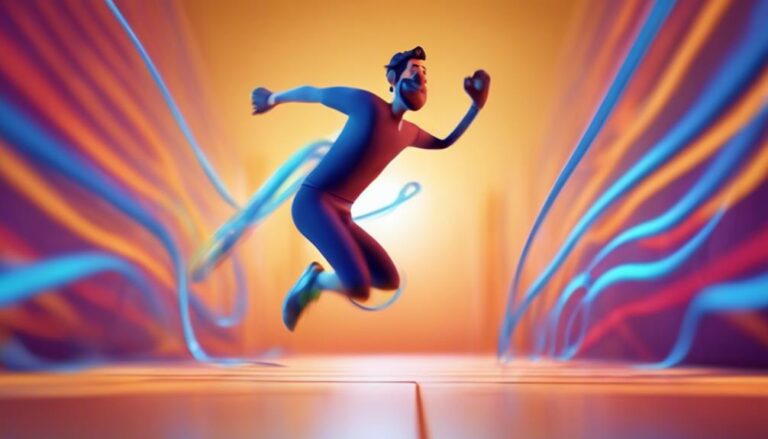10 Essential CGI Tips for Movie Magic
As you set out on your CGI journey, you're likely wondering what sets apart the breathtaking movie magic from the mediocre. The answer lies in mastering a range of techniques that can make or break the believability of your digital environments and characters. From accurately modeling light interaction to subtly animating characters, every detail counts. But where do you start? With so many factors at play, it's easy to get lost in the process. Get ready to uncover the secrets that will take your CGI skills to the next level and bring your visions to life in a way that will leave audiences mesmerized.
Key Takeaways
- Accurately model light interaction with objects, including scattering, absorption, and reflection, to create realistic lighting.
- Use subtle character movements, such as slight eyebrow raises and understated posture, to achieve realistic emotional responses.
- Focus on realistic terrain generation that mimics the natural world, incorporating geological principles and erosion simulation.
- Balance visual effects with storytelling goals, using VFX to amplify emotional resonance and reinforce character development.
- Ensure seamless integration of CGI elements with live-action footage, prioritizing lighting consistency, texture, and movement.
Mastering Realism in CGI Lighting
To create believable CGI scenes, you must first grasp the fundamentals of realistic lighting, which involves simulating the way light behaves in the physical world, from the subtle nuances of ambient Occlusion to the dramatic effects of high-contrast ratios.
This means accurately modeling the way light interacts with objects, including the way it scatters, absorbs, and reflects off various surfaces.
One key aspect of realistic lighting is soft shadows, which add depth and volume to your scene by creating subtle, gradual shifts between light and dark areas.
To achieve soft shadows, you'll need to adjust the light intensity, taking into account the distance and angle of the light source, as well as the material properties of the objects it's illuminating.
By carefully balancing light intensity and shadow softness, you can create a more immersive and convincing environment that draws the viewer in.
The Power of Subtlety in Animation
As you plunge into the world of CGI animation, you'll find that subtle nuances in character movement and expression can make all the difference in creating a believable and engaging performance. Animation nuance is key to bringing your characters to life, and it's often the small, almost imperceptible details that make the biggest impact.
| Over-the-top Animation | Subtle Animation |
|---|---|
| Exaggerated facial expressions | Slight eyebrow raises |
| Jerky, unnatural movements | Smooth, fluid gestures |
| Overly dramatic body language | Understated posture |
| Cartoonish reactions | Realistic emotional responses |
| Unnatural eye movements | Subtle eye darts and blinks |
Building Believable Digital Environments
When building believable digital environments, you'll need to focus on creating realistic terrain generation that mimics the natural world, from subtle texture variations to dramatic landscape features.
Next, you'll want to integrate atmospheric effects that simulate the way light behaves in the real world, such as fog, mist, and haze.
Realistic Terrain Generation
A solid understanding of geological principles is necessary to create realistic terrain, as it's the subtle variations in elevation, texture, and feature distribution that ultimately convince audiences of the environment's authenticity.
To achieve this, accurate terrain mapping is essential, which involves creating a detailed 3D representation of your terrain, taking into account factors such as elevation, slope, and aspect.
Next, incorporating erosion simulation adds a layer of realism to your terrain, achieved through algorithms that mimic natural erosion processes, such as water flow, sediment transport, and weathering. By simulating these processes, you can create realistic features like valleys, canyons, and coastlines.
When combining terrain mapping and erosion simulation, you'll be able to generate terrain that not only looks realistic but also behaves in a realistic way, helping to immerse your audience in the world you've created, making your digital environment feel more authentic and engaging.
Atmospheric Effects Integration
Integrating atmospheric effects into your digital environment is crucial for creating an immersive experience, as it allows you to simulate real-world phenomena like lighting, fog, and mist, which substantially impact the mood and believability of your scene.
To achieve this, you'll need to focus on cloud simulation and weather dynamics. Cloud simulation involves creating realistic cloud formations, which can greatly enhance the realism of your environment.
You can use techniques like volumetric rendering and particle simulation to create detailed, 3D clouds that interact with your scene's lighting.
Weather dynamics, on the other hand, involve simulating real-world weather conditions like rain, wind, and snow. This can be achieved through the use of physics-based simulations, which take into account factors like air pressure, temperature, and humidity.
By integrating these elements, you can create a more immersive and believable environment that draws your audience in. Remember to pay attention to the subtleties of atmospheric effects, as they can make or break the believability of your scene.
With careful planning and execution, you can create an environment that truly transports your audience to another world.
Scale and Proportion
Accurate scale and proportion are essential components of building believable digital environments, as they directly impact the audience's perception of spatial relationships and overall realism.
When creating virtual architecture, you must verify that every element, from buildings to props, is correctly sized and proportioned. This means weighing the scale of your models, taking into account the dimensions of real-world references, and adjusting them to fit your digital scene.
Model sizing is critical, as even slight discrepancies can throw off the entire environment. For example, if a character is supposed to walk through a doorway, the door's size and proportion must match the character's scale.
You'll also need to ponder the relationships between different objects within the scene, guaranteeing that they're correctly sized and positioned in relation to each other.
Avoiding the Uncanny Valley Trap
When creating photorealistic characters, you'll inevitably encounter the uncanny valley trap, where your CGI creations seem almost, but not quite, human.
To avoid this pitfall, you'll need to focus on crafting characters that are human-like but not human, embracing imperfections that make them more relatable and realistic.
Human-Like But Not Human
You'll need to carefully balance your character's human-like features with subtle deviations from realism to avoid plummeting into the uncanny valley, where audiences' emotional connections turn to discomfort and distrust. This delicate balance is vital when creating digital actors, as they need to evoke empathy without being too realistic.
To achieve this, focus on character nuances that make your digital actors relatable yet distinct from humans.
| Feature | Human-Like | Subtle Deviation |
|---|---|---|
| Facial Structure | Proportional features | Slightly oversized eyes or nose |
| Skin Texture | Realistic pores and wrinkles | Softened or exaggerated features |
| Movement | Human-like gestures | Slightly stiff or fluid movements |
| Eye Contact | Engaging gaze | Avoid direct eye contact or use delayed blinks |
Embracing Imperfections Naturally
By deliberately introducing minor flaws and inconsistencies into your digital characters, you can sidestep the uncanny valley trap and create a more authentic, relatable on-screen presence. This approach allows you to create characters that feel more human, rather than pushing for unrealistic perfection.
Embracing imperfections naturally can be achieved through various techniques, including:
Using organic textures to add subtle imperfections to your character's skin, clothes, and environment.
Imperfect simulations that mimic the unpredictability of real-life movements and interactions.
Introducing subtle asymmetries to facial features or body proportions.
Adding micro-movements and twitching to create a sense of nervous energy.
Incorporating subtle inconsistencies in lighting, shading, and reflection to create a more realistic atmosphere.
Subtle Expressions Matter
As you focus on creating a more authentic digital character, subtle facial expressions become a critical aspect of avoiding the uncanny valley trap, where even the slightest misstep can throw off the entire illusion.
To guarantee a convincing performance, mastering facial nuance is vital to convey emotional authenticity. You must verify that your digital character's expressions are subtle yet convey the intended emotions. This means paying attention to the slightest twitches, eyebrow movements, and lip curls.
When crafting these expressions, remember that less is often more. Avoid over-animated or exaggerated movements, as they can quickly fall into the uncanny valley.
Instead, focus on creating a sense of realism by studying human facial expressions and incorporating those subtleties into your character's design. By doing so, you'll create a more believable and relatable character that audiences can connect with on a deeper level.
Balancing Action With Realism
When crafting CGI sequences, your primary challenge lies in striking a delicate balance between heart-pumping action and grounded realism, guaranteeing that the audience remains invested in the story without being jolted out of the cinematic experience.
To achieve this balance, you need to carefully consider the following key elements:
Action Choreography: Verify that the action sequences are well-choreographed and follow the laws of physics, even when defying gravity or pushing the boundaries of human capability. This will help maintain a sense of realism and authenticity.
Realistic Pacing: Make sure the pacing of your action sequences is realistic and doesn't feel rushed or slowed down for the sake of drama. This will help the audience stay immersed in the scene.
Physicality and Weight: Give your CGI characters and objects a sense of physicality and weight, making their interactions with the environment believable and engaging.
Environmental Interactions: Certify that your CGI elements interact with the environment in a realistic way, taking into account factors like gravity, friction, and momentum.
Subtlety in Animation: Avoid over-the-top or exaggerated animations that can detract from the overall sense of realism. Instead, opt for subtle, nuanced movements that enhance the scene's credibility.
The Art of CGI Character Design
You must carefully craft CGI characters that not only capture the audience's attention but also convincingly inhabit the world you've created, possessing a tangible presence that resonates with the viewer. This requires a deep understanding of CGI anatomy, from the intricacies of facial expressions to the subtleties of body language.
| Character Aspect | Design Considerations | Tips for Realism |
|---|---|---|
| Facial Structure | Define facial muscles, bone structure | Study human anatomy, observe facial expressions |
| Body Proportions | Balance proportions, account for weight distribution | Research human physiology, consult with medical experts |
| Skin and Texture | Add imperfections, simulate aging | Observe human skin, use reference images |
| Hair and Fur | Simulate movement, vary textures | Study hair physics, consult with stylists |
| Accessories and Props | Add character nuance, context | Research cultural and historical accuracy, consult with set designers |
Making the Most of Motion Capture
By capturing the subtleties of human movement, you can inject life into your CGI characters, bridging the gap between their design and performance. Motion capture technology allows you to record the intricate details of human movement, from the way a character walks to the subtle gestures of their hands. However, it's not just about capturing data – it's about capturing the essence of human motion nuance.
To get the most out of motion capture, keep the following tips in mind:
- Understand capture constraints: Be aware of the limitations of your motion capture system and plan your shoot accordingly.
- Use a mix of capture methods: Combine marker-based and markerless capture techniques to achieve the most realistic results.
- Focus on the subtleties: Don't just focus on the big movements – capture the small, subtle gestures that bring characters to life.
- Work with experienced performers: Actors with motion capture experience can help you get the best results.
- Clean and refine your data: Take the time to review and refine your captured data to verify it's accurate and usable.
Enhancing Storytelling With VFX
Enhancing Storytelling With VFX
Visual effects can elevate a narrative by seamlessly integrating digital elements that not only complement the live-action components but also amplify the emotional resonance of key scenes.
As you aim to enhance storytelling with VFX, you need to focus on aligning your visual effects with your storytelling goals. This means identifying the emotional beats you want to hit and how VFX can support those moments.
One effective way to do this is by using visual metaphors to convey complex ideas or emotions. For instance, a character's inner turmoil could be represented through a swirling stormy environment or a fantastical creature.
By carefully crafting these visual metaphors, you can create a richer, more immersive storytelling experience.
When incorporating VFX into your narrative, consider how they can reinforce character development, foreshadow plot twists, or even create tension.
Think about how you can use VFX to evoke emotions, rather than simply showcasing flashy visuals.
Achieving Seamless CGI Integration
To effectively integrate CGI elements into your narrative, it's essential that they blend convincingly with live-action footage, which requires a deep understanding of how to balance lighting, texture, and movement between the two. As a filmmaker, you need to guarantee that your CGI elements don't stand out like a sore thumb, but rather complement the live-action elements. This can be achieved by paying close attention to the production design, cinematography, and overall aesthetic of your film.
Onset Supervision is critical, having a VFX supervisor on set can help guarantee that the CGI elements are properly aligned with the live-action footage, saving you time and money in the long run.
CGI Budgeting is key, allocate your budget wisely, prioritizing the most critical CGI elements that will have the greatest impact on your narrative.
Lighting Consistency is crucial, guarantee that the lighting in your CGI elements matches the lighting in your live-action footage, creating a seamless shift between the two.
Texture and Materiality are important, pay attention to the texture and materiality of your CGI elements, making sure they match the live-action elements.
Motion and Camera Movement are vital, guarantee that the motion and camera movement in your CGI elements are consistent with the live-action footage, creating a cohesive visual language.
Optimizing CGI for Visual Flow
When incorporating CGI elements into your narrative, you're tasked with guaranteeing they don't disrupt the visual flow, but rather enhance it by creating a harmonious balance between dynamic movement and subtle shifts.
To achieve this, you need to carefully consider visual pacing, which refers to the rhythm and tempo of your scene. A well-balanced visual pace will guide the viewer's attention, creating a sense of tension and release.
In terms of frame composition, pay attention to the placement and movement of CGI elements within the frame. Certify that they complement the camera movement and don't clash with it.
For instance, if the camera is panning left, your CGI elements should move in harmony with it, rather than against it. You can also use CGI to create subtle movements that enhance the visual flow, such as gentle animations or subtle particle simulations.
Frequently Asked Questions
How Do I Protect My CGI Work From Being Stolen or Plagiarized?
To safeguard your CGI work, you'll want to register your creations with the copyright office to establish legal ownership, providing a solid foundation for taking legal action against potential plagiarizers.
What Are the Best CGI Software Options for Beginners on a Budget?
You'll find affordable CGI software options with free trials, like Blender, Tilt Brush, and SketchUp, which offer student discounts, allowing you to experiment and find the best fit for your budget and skill level.
Can I Use CGI to Enhance or Restore Old or Damaged Film Footage?
You can leverage CGI to enhance or restore old or damaged film footage, enabling film preservation and archival rescue by carefully scanning, digitizing, and applying advanced algorithms to remove defects and stabilize the image.
How Do I Get Hired by a Major VFX Studio or Film Production Company?
To get hired by a major VFX studio or film production company, you'll need to focus on building a strong portfolio showcasing your skills and develop strategic networking habits, attending industry events and connecting with key professionals on LinkedIn.
Are There Any CGI Techniques That Can Be Used in Live Theater Productions?
You can bring cinematic flair to live theater productions by incorporating CGI techniques, such as stage projections and virtual sets, which allow for dynamic, immersive environments that enhance the audience's experience.
Conclusion
As you wrap up your CGI project, remember that mastering movie magic requires a delicate balance of art and science.
By incorporating these 10 essential tips, you'll be well on your way to creating immersive, believable, and mesmerizing digital environments and characters.
Now, put these techniques into practice, and your vision will come alive with convincing realism, drawing your audience into a world of wonder and awe.






